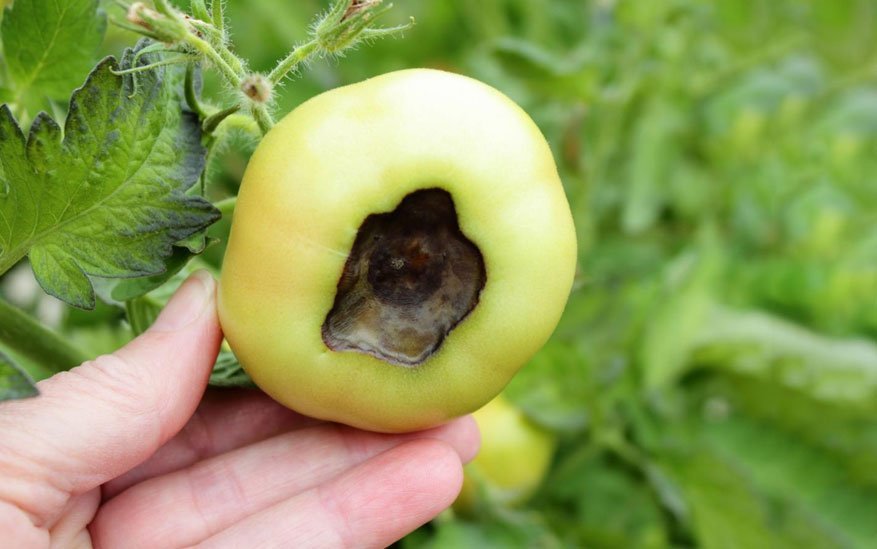There’s nothing more frustrating for a home gardener or farmer than seeing those ominous black blotches appearing on the tomatoes just as they start to ripen. These unsightly blemishes not only look unpleasant but can rot the tomato from the inside out, rendering fruits unsellable and unfit to eat.
Identifying and addressing the root causes of black spots on tomatoes is important to salvaging the harvest and preventing future outbreaks. Whether fungal, bacterial, environmental, pest-related, or due to nutritional deficiencies, understanding the problem is the first step towards an effective solution.
Understanding Black Spots on Tomato Plants
Black spots on tomatoes refer to dark blemishes that develop on the surface of tomatoe fruits and stems. These spots may start small, but can expand to cover large areas of the tomato skin leading to rotting and decay.
The black blotches are typically caused by fungal or bacterial pathogens that infect the plant and fruit. But environmental stresses and pests can also contribute by damaging the tomato externally, creating entry points for disease organisms to infiltrate and colonize. Even nutritional issues can make tomatoes more vulnerable to disorders leading to blackened spots.
Acting quickly when the first spots appear is key to limiting the infection and saving remaining healthy fruit on affected plants. A fast, accurate diagnosis will enable gardeners and farmers to apply appropriate solutions to match the specific causes involved.
Common Causes of Black Spots on Tomatoes
Many factors can trigger the appearance of black spots on ripening tomatoes. By familiarizing oneself with the typical causes, growers can make careful observations and draw the right conclusions when blotches show up in their crops:
Fungal Infections
Several common fungal pathogens are implicated in black spots on tomatoes:
- Early blight (Alternaria solani): One of the most prevalent culprits, this fungus first manifests itself as dark lesions on older leaves and stems. As it spreads to fruits, it creates dark, sunken, leathery black spots that may have concentric rings.
- Late blight (Phytophthora infestans): These blotches are more irregular in shape and often start at the stem end of tomatoes. A fuzzy white mold may appear on surface of spots under humid conditions that promotes pathogen growth.
- Septoria leaf spot (Septoria lycopersici): Round black spots sometimes surrounded by yellow halos appear first on lower leaves, later spreading to stems and fruit. When severe, spots can coalesce to rot large areas.
- Anthracnose (Colletotrichum coccodes): Also causes dark, sunken lesions on ripening tomatoes, usually with an oval shape and concentric rings. Mainly affects overripe or damaged fruit.
Fortunately there are preventative measures and organic treatments that can curb most fungal diseases:
- Practicing crop rotation, removing diseased plant debris after harvest, staking plants, and improving air circulation all help restrict fungal growth.
- After first appearance, act fast to treat plants with neem oil or copper-based fungicides.
- Switch to drip irrigation to avoid wetting foliage which spreads spores.
Bacterial Diseases
Two major bacterial afflictions can also manifest as black spots on tomatoes:
- Bacterial speck (Pseudomonas syringae pv. tomato): Causes small, raised black spots surrounded by yellow halos on younger leaves and under 1⁄4 inch black lesions on fruits. The bacterium thrives in cool, moist conditions.
- Bacterial spot (Xanthomonas campestris pv. vesicatoria): More aggressive than speck, with slightly larger black spots that often merge into large decayed blotches. Lower leaves show brown margins as they wilt.
Once bacterial diseases take hold, home remedies have limited success. Prevention is critical:
- Purchase certified disease-free transplants. Inspect them closely before planting out.
- Wash hands and sanitize tools between working with different plants.
- Support plants to keep foliage off the ground to avoid splash dispersal from soil onto leaves.
- Apply approved copper bactericides weekly as a protective spray starting when fruits form.
Environmental Stress
Even tomato plants lacking any disease organism can develop black blotches if faced with suboptimal environmental conditions:
- Temperature extremes – Cold snaps or intense heat waves can damage cell structure, causing surface blemishes. Offer protection from extremes.
- Poor air circulation -Dense foliage traps stagnant moisture promoting fungal and bacterial growth. Prune leaves and stake/trellis vines.
- Heavy rains – Cracked skin from excessive soil moisture allows decay organisms entry. Use drip irrigation and foliar fungicides.
- Sunscald – Fruits exposed to direct summer sun can develop black leathery patches. Partial shade helps prevent this.
Stressed plants also become more vulnerable to infections, so optimizing the tomato’s growing conditions bolsters its defenses.
Nutritional Deficiencies
Like humans, tomato plants need proper nutrition in order to develop normally and resist disorders. Deficiencies commonly tied to black blotches on fruit include:
- Calcium: Blossom end rot (sunken black spots) results from inadequate calcium, often due to low soil pH or uneven watering.
- Potassium: supports disease resistance and fruit quality. Low levels increase risk of spotting.
- Magnesium: needed to form chlorophyll and defend against fungal intrusions. Blotchy yellow areas may turn black.
A balanced organic tomato fertilizer with a full spectrum of macronutrients and micronutrients is enormously beneficial. For calcium, supplementary bone meal or crushed eggshells can help prevent blossom end rot. A compost mulch also nurtures the soil food web to better feed tomatoes.
Pest Damage
In their quest to taste our tasty tomatoes, insects and other garden pests facilitate the entry of disease:
- Tomato hornworms and fruitworms create holes, cracks, and wounds that serve as prime targets for infection by opportunistic pathogens. Plus they eat the fruit itself! Handpick pests to keep populations in check. Cover plants with fine netting if needed.
- Stink bugs and thrips that pierce tomato skins to feed leave behind entry points for bacteria and fungi. Knock off bugs with blasts of water; spray affected fruits with diluted hydrogen peroxide.
- Rodents like voles gnaw at ripening tomatoes exposing the inner flesh. Set humane traps and fence beds to protect fruits.
As wounded tomatoes are very prone to infection, be vigilant in safeguarding them from pest damage.
“An ounce of prevention is worth a pound of cure.” – Benjamin Franklin
The proactive gardener takes heed of this sage advice when raising robust tomato plants. Identifying and addressing threats early, before they escalate into full-fledged epidemics, is much more effective than reacting once disaster strikes. A careful eye and quick response time are vital weapons in the battle against black spots.
Diagnosing Black Spots on Your Tomato Plants
When black blotches first emerge on precious tomato fruits and foliage, take time to properly diagnose the specific cause. Take detailed notes and capture images of the spots based on these helpful guidelines:
- Carefully observe where spots first occur – older vs younger leaves, higher vs lower plant sections, shaded vs exposed areas. This reveals vulnerabilities.
- Size and shape offer clues to the culprit. Irregular water-soaked lesions? Circular with concentric rings? Related to insect feeding sites?
- The rate of spread indicates aggressiveness level. Do spots expand rapidly across plant tissues? Have they reached fruit yet?
- Coexisting symptoms like leaf yellowing, wilting foliage, flattened stems, and the like point to possible nutrient issues, bacteria, etc.
- Weather conditions enable linking patterns to excessive rains, humidity, frosts, etc. Have other plants been struck too?
Like a detective gathering evidence at a crime scene, piecing together all these data points will lead to an accurate diagnosis, allowing for swift and decisive action to treat the afflicted tomatoes.
Preventative Measures for Healthy Tomato Plants
While many fungicides and bactericides treat active infections, preventing black spots from ever taking hold is the ultimate goal. Proactive measures on several fronts make tomatoes less disease-prone and more resilient:
Cultural Practices
- Start with disease-resistant varieties when possible to avoid inherent vulnerabilities. The tradeoff is sometimes lower yields or milder flavor, so also plant more prone heirlooms.
- Crop rotation prevents the buildup of soil-dwelling disease organisms. Don’t plant tomatoes in the same spot more than once every 3 years.
- Staking and pruning improve air circulation and decrease moisture levels. Also avoids soil contacting leaves and fruit.
- Weed control eliminates shelter and breeding grounds for pathogenic fungi and bacteria. Weeds also compete for nutrients, weakening tomatoes.
- Sanitize tools and hands between working with different plants to avoid transmitting infections through gardening activities.
Chemical Treatments
When used judiciously according to label instructions, certain chemicals offer protective benefits:
- Fungicides containing chlorothalonil or mancozeb shield against fungal leaf spots and blights. But allow listed preharvest interval before consuming fruit.
- Copper fungicides boost plant defenses against many bacterial and fungal pathogens without toxic effects (unlike synthetic chemicals). Best applied preventatively before infections manifest.
- Bactericides with streptomycin sulfate kill bacterial invaders like spots and specks, but plants can develop resistance with overuse. Rotate antibiotics used from season to season.
Always practice moderation with chemical inputs to safeguard soil, environmental, and human health.
Organic Remedies
For home gardeners wishing to avoid synthetic chemicals, nature provides its protectants:
- Bacillus subtilis bacteria colonize surfaces preventing pathogens from gaining a foothold. Look for Serenade Garden Disease Control or other bio fungicides containing this beneficial strain. It leaves no toxic residues.
- Neem oil, extracted from the Indian neem tree, smothers fungal growth and deters insect pests. Use a diluted 0.5% solution as a weekly foliar spray for prevention.
- Mix 1 tbsp baking soda and 2.5 tbsp horticultural oil into 1 gallon water. This DIY fungicide coats leaves with a protective barrier against spores and bacteria. Shake well before spraying.
While not as instantly potent on active infections, these organic options offer worthwhile guard rails against black spots while nurturing the overall ecosystem.
Consistent Care Routine for Tomatoes
Just as consistent grooming keeps our dog or cat healthy, establishing a routine care regimen safeguards tomato plants over the entire growing season. Important activities include:
- Spring planting of disease-free transplants spaced 18-24 inches apart. Dig in compost and fertilize new plantings.
- Install trellising/staking/cages when plants are 6 inches tall to improve airflow as they grow.
- Apply a thick 4-6 inch organic mulch layer to retain soil moisture and nourish helpful microbes.
- Scout daily for emerging symptoms of diseases and insect issues. Take prompt remedial actions.
- Treat preventatively with fungicides/bactericides weekly, especially during damp periods favorable to pathogens. Rotate materials used.
- Prune lower foliage and branches with secateurs wiped with alcohol between plants to remove senescing leaves and improve air circulation deep in the canopy.
- Pick fruits as they ripen, checking thoroughly for black blotches. Discard severely infected tomatoes.
- As crop winds down, pull spent plants and discard in trash, not compost.
Making such vigilant plant care a set routine across the tomato growing season gives crops the best chance to avoid threats like black spots while reaching full genetic potential.
Quick Guide to Managing Black Spots on Tomatoes
| Cause | Signs | Solutions |
|---|---|---|
| Early Blight | Dark leathery spots on leaves/stems spreading to fruits | Improve airflow. Remove infected plants. Apply fungicides. |
| Late Blight | White fuzzy mold on irregular black blotches | Lower humidity. Prune infected parts. Fungicides with chlorothalonil. |
| Bacterial Speck | Tiny black dots with yellow halos on leaves/fruits | Purchase disease-free plants. Apply copper sprays as prevention. |
| Sunscald | Black leathery patches on the shoulders of exposed fruits | Filter sunlight with row covers or shading. |
| Hornworms | Large worms with white stripes eating foliage and fruits | Handpick and dispose of pests. Cover with netting. |
| Blossom End Rot | Sunken black spot at the bottom of the tomatoes | Mulch and water evenly. Add calcium supplements. |
Having such a cheat sheet offers a handy diagnostic tool for growers dealing with black blotches on their precious tomato crop. Matching observed symptoms to solutions can accelerate recovery.
Tips for Keeping Tomatoes Healthy
With any thriving garden, an ounce of prevention is truly worth a pound of cure when growing robust tomato plants. Useful protips include:
- Seek out tomato varieties bred with disease resistance – look for letters like V, F, N, or T in catalog descriptions indicating enhanced virus/fungal/nematode/tobacco mosaic virus defenses.
- Use soaker hoses to irrigate at soil level rather than overhead watering. This avoids wetting foliage which spreads spores. Drip irrigation works too.
- Stake up vines and prune lower leaves improving sunshine and breeze penetration to limit local humidity levels conducive to fungal and bacteria growth.
- Plant “sacrificial trap crops” like radishes and nasturtiums around tomato beds. Being more vulnerable, these will show disease symptoms earlier and alert gardener to dangers facing tomatoes.
- To treat black blotches agrichemicals can’t combat, try using hydrogen peroxide spray (1 part HP to 4 parts water). The bubbling action kills bacteria and fungus occupying lesions.
Tomato Disease Statistics – Applying the Facts
Gaining some perspective on the prevalence of tomato afflictions can spur us to be more proactive:
- Between bacterial, viral, and fungal attackers – plus environmental stresses – up to 80% of homegrown tomatoes can develop disease issues during cooler, wetter growing seasons.
- Of these troubles, over 65% arise from fungal or bacterial origins – precisely the kind that cause black spots and rotting. Early blight alone affects 75% of tomato plants by season end in some regions.
- However, simple practices like staking/pruning, crop rotation, and sanitation can slash fungal infection rates by 50% or more. Several studies found 85% less early blight incidence with interventions.
- Likewise, preventative copper sprays demonstrably limit the appearance of bacterial spot and speck colonies by over 60%.
Clearly, knowledge combined with targeted action makes a dramatic difference in curtailing black spots. We must tip the scales back in favor of healthy tomatoes!
Conclusion
Left unchecked, the appearance of dark malignant lesions on tomato fruits signals impending losses – both in terms of yields and production quality. Swift sleuthing to uncover specific causes combined with prompt counteractions offers the best hope of salvaging one’s crop.
Whether facing fungal invaders, bacterial infiltrators, environmental adversity, pest pressures or nutritional deficiencies, tomato plants need their caretaker’s help repelling these threats. Robust preventative practices, early-warning monitoring, and decisive follow-up care reinforced by an understanding of plant epidemiology all combine to keep harvests rolling in.
While some black spots can dash growers’ dreams if left unchecked, awareness and action can sustain an abundant backyard bounty. So take heart, sharpen thy pruners, ready thy remedies, and let not those blemishes gain purchase in thy tomato patch! The fruits of healthy plants await.




No Comment! Be the first one.